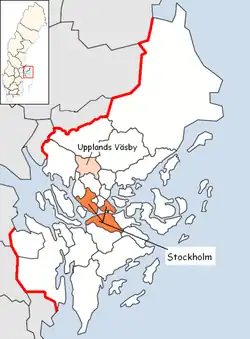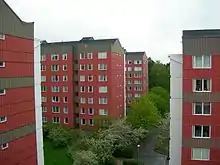Upplands Väsby Municipality
Upplands Väsby kommun | |
|---|---|
 | |
 Coat of arms | |
 | |
| Coordinates: 59°31′N 17°55′E / 59.517°N 17.917°E | |
| Country | Sweden |
| County | Stockholm County |
| Seat | Upplands Väsby |
| Area | |
| • Total | 83.81 km2 (32.36 sq mi) |
| • Land | 75.09 km2 (28.99 sq mi) |
| • Water | 8.72 km2 (3.37 sq mi) |
| Area as of 1 January 2014. | |
| Population (31 December 2021)[2] | |
| • Total | 47,820 |
| • Density | 570/km2 (1,500/sq mi) |
| Time zone | UTC+1 (CET) |
| • Summer (DST) | UTC+2 (CEST) |
| ISO 3166 code | SE |
| Province | Uppland |
| Municipal code | 0114 |
| Website | www.upplandsvasby.se |
Upplands Väsby Municipality (Upplands Väsby kommun) is a municipality in Stockholm County in east central Sweden, with a population of 38,963 (2010). Its seat is located in the town of Upplands Väsby.
The municipality was created in connection with the municipal reform of 1952, when the rural municipalities Ed, Fresta and Hammarby were amalgamated. It got its name from a settlement which had evolved around the railway station.
The name Väsby can be attested (as Vesby) from the 13th century. The prefix "Upplands" came to be used by the post station in 1919 as a means of separating it from other Väsbys in the country. The municipality was then named "Upplands-Väsby" for a time, but the dash was removed on 19 September 2002.
Geography
Upplands Väsby is located in between Stockholm and Arlanda Airport, and the East Coast Line railroad goes through the municipality. There are local train services to Arlanda Airport, Uppsala, Stockholm Central Station and Älvsjö (Stockholm commuter rail).
The land[3] is covered with good soil, forests, and moraine. The western part border to a creek of the lake Mälaren (not visible on the map), which also marks the border to the municipality Upplands-Bro. There are also other water areas, such as streams and small lakes, in the municipality. One of them is the small river Väsbyån, flowing through Väsby, in which the uncommon fish asp swims.
History
Located in the province of Uppland the municipality holds remains from the Stone Age. Runestones and axes from the Bronze Age have also been found. The number of rune inscriptions in the municipality amounts to 76.
When Väsby Centrum, a shopping centre that currently houses some 60 stores, was built in Väsby in 1972 the population grew markedly. The mall is currently undergoing a large increase; 20 new stores will have opened by spring 2007, bringing the mall's total up to 80 stores.
Demography

2022 by district
This is a demographic table based on Upplands Väsby Municipality's electoral districts in the 2022 Swedish general election sourced from SVT's election platform, in turn taken from SCB official statistics.[4]
Residents include everyone registered as living in the district, regardless of age or citizenship status. Valid voters indicate Swedish citizens above the age of 18 who therefore can vote in general elections. Left vote and right vote indicate the result between the two major blocs in said district in the 2022 general election. Employment indicates the share of people between the ages of 20 and 64 who are working taxpayers. Foreign background is defined as residents either born abroad or with two parents born outside of Sweden. Median income is the received monthly income through either employment, capital gains or social grants for the median adult above 20, also including pensioners in Swedish kronor. The section about college graduates indicates any degree accumulated after high school.
In total there were 47,696 residents, including 32,973 Swedish citizens of voting age.[4] 47.3 % voted for the left coalition and 50.8 % for the right coalition.
| Location | Residents | Valid voters | Left vote | Right vote | Employed | SV parents | 1st/2nd gen | Income | College |
|---|---|---|---|---|---|---|---|---|---|
| % | % | % | % | % | % | ||||
| Apoteksskogen | 1,596 | 1,023 | 54.8 | 42.7 | 74 | 35 | 65 | 23,003 | 40 |
| Brunnby | 2,031 | 1,292 | 38.7 | 59.5 | 81 | 58 | 42 | 27,788 | 41 |
| Edssjön | 1,950 | 1,246 | 50.5 | 47.2 | 88 | 60 | 40 | 32,252 | 55 |
| Ekebo | 1,602 | 987 | 57.4 | 40.1 | 73 | 33 | 67 | 22,043 | 40 |
| Folkparken | 1,500 | 1,180 | 50.3 | 48.1 | 83 | 61 | 39 | 26,529 | 47 |
| Frestaby | 1,508 | 1,079 | 39.7 | 59.6 | 86 | 73 | 27 | 32,069 | 39 |
| Fyrklövern N | 854 | 813 | 55.9 | 40.9 | 72 | 42 | 58 | 18,151 | 39 |
| Fyrklövern S | 1,491 | 936 | 58.0 | 37.0 | 68 | 21 | 79 | 18,922 | 33 |
| Fysinge | 1,531 | 1,091 | 38.5 | 60.7 | 77 | 54 | 46 | 26,688 | 39 |
| Gamla Bollstanäs | 1,569 | 1,162 | 38.9 | 60.5 | 87 | 74 | 26 | 34,825 | 51 |
| Grimstaby | 2,319 | 1,725 | 42.7 | 56.5 | 84 | 75 | 25 | 31,550 | 43 |
| Korpkulla | 1,589 | 1,276 | 53.1 | 44.8 | 79 | 50 | 50 | 25,951 | 50 |
| Mälaren | 1,396 | 1,075 | 48.7 | 50.2 | 82 | 68 | 32 | 29,167 | 47 |
| Nedra Runby | 1,513 | 1,119 | 52.1 | 46.4 | 80 | 63 | 37 | 26,880 | 45 |
| Norra Bollstanäs | 2,092 | 1,394 | 37.4 | 61.6 | 87 | 78 | 22 | 38,890 | 54 |
| Odenslunda N | 1,715 | 1,156 | 41.3 | 57.8 | 84 | 61 | 39 | 31,331 | 45 |
| Odenslunda S | 1,651 | 1,224 | 40.1 | 58.6 | 83 | 66 | 34 | 30,182 | 41 |
| Prästgårdsmarken | 1,898 | 1,236 | 49.7 | 47.4 | 77 | 51 | 49 | 25,247 | 34 |
| Sigma | 1,816 | 1,026 | 59.3 | 35.4 | 70 | 28 | 72 | 22,460 | 34 |
| Sjukyrkoberget | 1,597 | 1,143 | 44.1 | 55.6 | 87 | 70 | 30 | 33,279 | 48 |
| Skälby | 1,682 | 1,311 | 46.4 | 51.6 | 76 | 55 | 45 | 24,544 | 34 |
| Smedby N | 1,529 | 914 | 53.3 | 43.2 | 71 | 37 | 63 | 22,958 | 33 |
| Smedby S | 1,655 | 1,130 | 46.7 | 50.3 | 75 | 53 | 47 | 25,699 | 28 |
| Vilunda | 1,498 | 1,078 | 53.0 | 45.9 | 79 | 53 | 47 | 23,974 | 44 |
| Väsbyskogen V | 2,051 | 1,560 | 53.1 | 45.0 | 80 | 52 | 48 | 27,825 | 49 |
| Väsbyskogen Ö | 2,036 | 1,111 | 59.3 | 35.3 | 65 | 24 | 76 | 18,870 | 29 |
| Ö Frestaby-Ekeby | 2,041 | 1,355 | 34.9 | 63.7 | 87 | 71 | 29 | 32,624 | 43 |
| Övra Runby | 1,986 | 1,331 | 52.0 | 46.7 | 77 | 65 | 35 | 27,726 | 47 |
| Source: SVT[4] | |||||||||
Population development
| Year | Population | ||||||||
|---|---|---|---|---|---|---|---|---|---|
| 1970 | 19,032 | ||||||||
| 1975 | 28,810 | ||||||||
| 1980 | 31,961 | ||||||||
| 1985 | 33,912 | ||||||||
| 1990 | 35,963 | ||||||||
| 1995 | 36,277 | ||||||||
| 2000 | 37,576 | ||||||||
| 2005 | 37,624 | ||||||||
| 2010 | 39,289 | ||||||||
| 2015 | 42,661 | ||||||||
| 2017 | 44,605 | ||||||||
| 2019 | 46,786 | ||||||||
|
Source: SCB - Folkmängd efter region och år. | |||||||||
Residents with a foreign background
On 31 December 2017 the number of people with a foreign background (persons born outside of Sweden or with two parents born outside of Sweden) was 17 533, or 39.31% of the population (44 605 on 31 December 2017). On 31 December 2002 the number of residents with a foreign background was (per the same definition) 10 132, or 27.06% of the population (37 444 on 31 December 2002).[5] On 31 December 2017 there were 44 605 residents in Upplands Väsby, of which 13 009 people (29.16%) were born in a country other than Sweden. Divided by country in the table below - the Nordic countries as well as the 12 most common countries of birth outside of Sweden for Swedish residents have been included, with other countries of birth bundled together by continent by Statistics Sweden.[6]
| Country of birth[6] | ||
|---|---|---|
| 31 December 2017 | ||
| 1 | 31,596 | |
| 2 | 2,013 | |
| 3 | Asia: Other countries | 1,614 |
| 4 | 1,393 | |
| 5 | 1,342 | |
| 6 | Africa: Other countries | 913 |
| 7 | 747 | |
| 8 | South America | 725 |
| 9 | 657 | |
| 10 | 962 | |
| 11 | 495 | |
| 12 | 381 | |
| 13 | 290 | |
| 14 | North America | 231 |
| 15 | 217 | |
| 16 | SFR Yugoslavia/ | 199 |
| 17 | 171 | |
| 18 | 159 | |
| 19 | 133 | |
| 20 | 128 | |
| 21 | 87 | |
| 22 | 81 | |
| 23 | 34 | |
| 24 | 22 | |
| 25 | Oceania | 12 |
| 26 | Unknown country of birth | 3 |
References
- ↑ "Statistiska centralbyrån, Kommunarealer den 1 januari 2014" (in Swedish). Statistics Sweden. 2014-01-01. Archived from the original (Microsoft Excel) on 2016-09-27. Retrieved 2014-04-18.
- ↑ "Folkmängd i riket, län och kommuner 31 december 2021" (in Swedish). Statistics Sweden. February 22, 2022. Retrieved February 22, 2022.
- ↑ "Google Maps".
- 1 2 3 "Valresultat 2022 för Upplands Väsby i riksdagsvalet" (in Swedish). SVT. 11 September 2022. Retrieved 7 January 2024.
- ↑ Antal personer efter region, utländsk/svensk bakgrund och år (Read 5 januari 2019)
- 1 2 Statistiska centralbyrån: Utrikes födda efter län, kommun och födelseland 31 december 2017 (XLS-fil) Läst 5 januari 2019
External links
- Upplands Väsby Municipality - Official site
- Väsby Centrum (in Swedish)